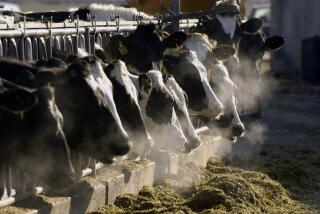FDA Gives Spinach a Qualified OK
Is it safe to eat spinach?
The U.S. Food and Drug Administration Friday answered that question with a qualified yes, lifting a warning against eating fresh bagged spinach from California’s Central Coast -- except for certain products already recalled because of a nationwide E. coli outbreak.
But officials didn’t exactly declare spinach risk-free.
“Based on where we are at this point of the investigation,” said David Acheson, chief medical officer for the FDA’s food safety division, “it is as safe as it was before this event.”
The move followed a two- week scare in which one person died and 186 others fell ill from eating spinach contaminated by a virulent form of E. coli -- the largest such outbreak ever recorded involving the Salinas Valley area. The greens were traced to Natural Selection, a large grower and processor based in San Juan Bautista.
Not long after clusters of cases were identified in multiple states, federal officials on Sept. 14 called upon consumers to avoid all fresh spinach, later narrowing the warning to spinach from three counties on California’s Central Coast, the heart of the nation’s spinach industry.
On Friday, officials honed that warning further, limiting it to more than 40 brands with “best if used by” dates of Aug. 17 through Oct. 1.
But in a news teleconference Friday, Acheson sounded anything but enthusiastic about lifting the advisory. He took note of the 20 E. coli outbreaks from lettuce and spinach since 1995, nine involving the Salinas Valley.
“Until some fundamental fixes are put in place in the areas where this contamination is happening,” he said, “there is obviously a concern that two months from now we’ll be having the same conversation, talking about outbreak number 21.”
California health officials offered about as enthusiastic a thumbs up.
“This could happen again, because we systemically have, we suspect, chronic sources of contamination in the Salinas Valley,” said Kevin Reilly, deputy director for prevention services at the state Department of Health Services.
Possible sources include contaminated water, manure from nearby cattle farms, other animal droppings and poor worker hygiene.
The spinach industry issued a measured response to the FDA’s action. In a prepared statement, a coalition of produce growers, processors and shippers said: “We will work aggressively with the Food and Drug Administration and state regulatory authorities to ensure the industry’s growing and processing practices continue to be based on the very best scientific information available and that we are doing everything possible to provide the nation with safe and healthy produce.”
Although federal and state health officials have narrowed the search for what caused the current outbreak to Natural Selection and to nine farms that supplied it with spinach, they have not yet found the actual source of the bacteria, which are so deadly that as few as 10 of them can cause serious illness. As past investigations have shown, they may never find it.
The good news Friday was that the federal Centers for Disease Control stopped releasing new numbers of illnesses and deaths daily -- a reassuring sign, state officials said, that the outbreak is tapering off.
However, hardly anyone has been eating spinach for the last two weeks.
The spinach-growing season in the Greater Salinas Valley has about one more month -- or one more harvest -- before the weather turns relatively cold and spinach-growing moves south to Imperial County and Yuma, Ariz.
Natural Selection, for one, won’t be packaging any spinach, under any brand, until then. And when it does, it will put in place new safety measures not used anywhere else in the industry, the company announced earlier this week.
“I think you can be assured that the growers and the companies that are going to be processing this product are going to be vigilant,” said Christine Bruhn, director of the Center for Consumer Research at UC Davis.
“I might have more confidence in the California product right now than maybe anywhere else. I think California is going to be on their toes like they’ve never been before.”
If still worried, consumers should saute the spinach. “Cook it well, put a little oil, a little butter, whatever you like, and saute it well, and it’s safe,” advises Bruhn.
Food safety experts say producers and regulators should be careful not to let down their guard.
“After a crisis, everyone responds. Everyone will up their safety checks,” said Caroline Smith DeWaal, food safety director for the Center for Science in the Public Interest.
“But in six months ... they may start being more lax again, and that’s when it’s critical that the government be on the case.”
Meat, fish and poultry are subject to mandatory government standards designed to prevent contamination at each step of the process that brings those foods to consumers.
But the government issues only voluntary guidelines for produce. The current spinach recall is voluntary.
The FDA guidelines -- known as “good agricultural practices” -- include irrigating with clean water, providing toilet facilities for pickers, making sure animals don’t contaminate produce in packing sheds, properly washing fresh produce and maintaining correct temperatures during shipping. Since 2004, the FDA has been urging closer adherence to these practices among California growers of leafy greens, including spinach.
“Frankly, to date, the voluntary process has not resulted in prevented outbreaks,” Reilly said.






